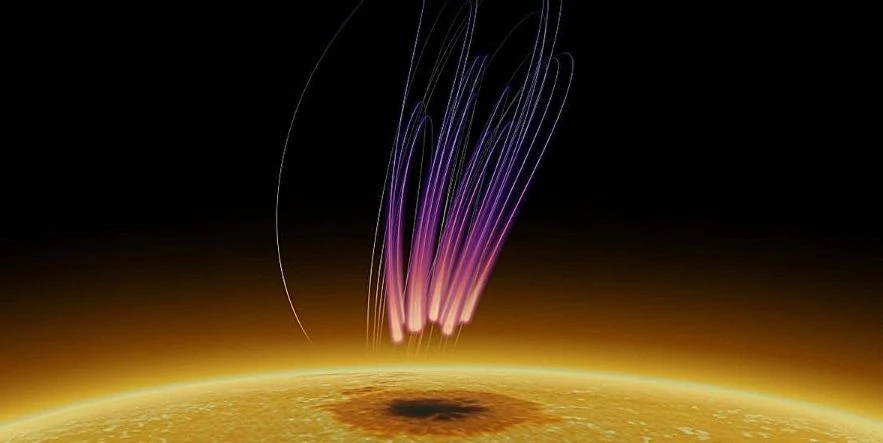NJIT astronomers reveal unique aurora-like radio emission above sunspot

In a groundbreaking study published in Nature Astronomy, researchers from the New Jersey Institute of Technology’s Center for Solar-Terrestrial Research (NJIT-CSTR) have documented an extraordinary aurora-like radio emission occurring approximately 40 000 km (25 000 miles) above a sunspot. This novel radio emission, which shows characteristics akin to the auroral emissions observed around planets like Earth, Jupiter, and Saturn, presents an unprecedented understanding of solar radio bursts and their potential link to similar phenomena in stars with large starspots.
The team at NJIT-CSTR, led by scientist Sijie Yu, has made a significant discovery in solar research. They detected an unusual type of long-lasting polarized radio burst emanating from a sunspot, which persisted for over a week. This contrasts sharply with the typical, transient solar radio bursts that usually last only minutes or hours. This discovery is pivotal, potentially reshaping our understanding of stellar magnetic processes.
Earth’s famous auroral light shows, such as the Aurora Borealis or Aurora Australis, occur when solar activities disturb Earth’s magnetosphere, leading to the precipitation of charged particles in the polar regions where they interact with atmospheric gases. These interactions generate intense radio emissions at frequencies around a few hundred kHz. The sunspot radio emissions observed by Yu’s team, however, differ markedly from the known solar radio noise storms, both in their spectral and temporal characteristics.
The researchers suggest that these emissions result from electron-cyclotron maser (ECM) emission, involving energetic electrons trapped within converging magnetic fields. The cooler and intensely magnetic areas of sunspots provide an ideal environment for ECM emissions, drawing parallels with the magnetic polar caps of planets and other stars. However, the sunspot aurora emissions occur at much higher frequencies – from hundreds of thousands to approximately 1 million kHz – due to the sunspot’s magnetic field being thousands of times stronger than Earth’s.
Yu’s team’s findings indicate that these radio bursts are not necessarily linked to solar flares. Instead, they appear to be powered by sporadic flare activity in nearby regions, which injects energetic electrons into large-scale magnetic loops anchored at the sunspot. This results in the ECM radio emission above the region.
Interestingly, the “sunspot radio aurora” seems to exhibit rotational modulation in sync with the solar rotation, creating a “cosmic lighthouse effect.” As the sunspot moves across the solar disk, it generates a rotating beam of radio light, akin to the modulated radio aurora observed from rotating stars. This phenomenon represents the first detection of its kind, prompting the team to conduct retrospective analyses to identify potential instances of this emission in previously recorded solar bursts.
While weaker than stellar auroral emissions observed in the past, these solar radio emissions are thought to be similar and may imply that starspots on cooler stars could be sources of certain radio bursts in various stellar environments.
This observation, according to Bin Chen, an associate professor of physics at NJIT-CSTR, is among the clearest evidence of radio ECM emissions seen from the sun, bearing resemblance to phenomena observed on our planets and distant stars. This leads to considerations of whether this model could be applicable to other stars with starspots.
The insights gained from this study have significant implications for astrophysical research, linking the behavior of our sun with the magnetic activities of other stars. This understanding could lead to a reevaluation of current models of stellar magnetic activity.
References:
1 Scientists uncover aurora-like radio emission above a sunspot – NJIT – November 13, 2023
2 Detection of long-lasting aurora-like radio emission above a sunspot – Sijie Yu et al. – Nature Astronomy – November 13, 2023 – DOI https://doi.org/10.1038/s41550-023-02122-6
Featured image credit: Sijie Yu

This is extremely valuable solar observation showing externally powered Sun. But, as usual, the interpretation of this observation is wrong and intended to suit the dogmatic standard solar mode. First of all, according to my understanding, the detection of this solar phenomenon shows once again the ultra-energetic cosmic particles that power the Sun (the external energy supply). This external energy which varies on the solar body and with solar cycle is the one that triggers all types of solar eruptions. Read the rest at https://www.gsjournal.net/Science-Journals/Essays-Cosmology/Download/9746